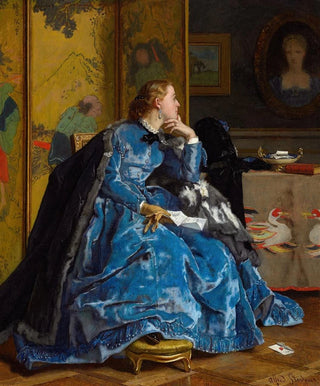Art print | A duchess in a blue dress - Alfred Stevens


View from behind

Frame (optional)
The art print "A Duchess in a Blue Dress" by Alfred Stevens is a piece that evokes the sophistication and elegance of the 19th century. This painting, both delicate and powerful, immerses us in the world of Parisian salons, where fashion and art blend harmoniously. The duchess, the central figure of this composition, embodies not only beauty but also the social status and refinement of her era. Through the nuances of blue in her dress, Stevens manages to capture the light and the very essence of his model, while offering us a glimpse into the aristocratic life of his time.
Style and uniqueness of the work
Alfred Stevens' style is distinguished by his ability to marry realism and idealization. In "A Duchess in a Blue Dress," every detail is meticulously crafted, from the folds of the dress to the reflections of light on the fabrics. The chosen color palette, dominated by shades of blue, evokes an atmosphere of serenity and luxury. The artist employs painting techniques that highlight the texture of the materials, making the softness of the silk almost tangible. Moreover, the duchess's pose, both relaxed and majestic, demonstrates mastery of posture that reinforces the idea of feminine power. Stevens, a true portraitist, knows how to capture not only the external appearance but also the aura of his models, creating an emotional connection with the viewer.
The artist and his influence
Alfred Stevens, born in 1823 in Brussels, established himself as one of the most prominent painters of his time. Trained at the Royal Academy of Fine Arts of Brussels, he later settled in Paris, where he became an influential member of the artistic community. His work, often focused on themes related to fashion and the daily life of aristocratic women, allowed him to build a reputation as a preferred portraitist. Stevens drew inspiration from the great masters while developing his own style, blending romanticism and realism. His influence extends beyond his own production, inspiring many contemporary and future artists, who see in him a pioneer of female representation in the

Matte finish

View from behind

Frame (optional)
The art print "A Duchess in a Blue Dress" by Alfred Stevens is a piece that evokes the sophistication and elegance of the 19th century. This painting, both delicate and powerful, immerses us in the world of Parisian salons, where fashion and art blend harmoniously. The duchess, the central figure of this composition, embodies not only beauty but also the social status and refinement of her era. Through the nuances of blue in her dress, Stevens manages to capture the light and the very essence of his model, while offering us a glimpse into the aristocratic life of his time.
Style and uniqueness of the work
Alfred Stevens' style is distinguished by his ability to marry realism and idealization. In "A Duchess in a Blue Dress," every detail is meticulously crafted, from the folds of the dress to the reflections of light on the fabrics. The chosen color palette, dominated by shades of blue, evokes an atmosphere of serenity and luxury. The artist employs painting techniques that highlight the texture of the materials, making the softness of the silk almost tangible. Moreover, the duchess's pose, both relaxed and majestic, demonstrates mastery of posture that reinforces the idea of feminine power. Stevens, a true portraitist, knows how to capture not only the external appearance but also the aura of his models, creating an emotional connection with the viewer.
The artist and his influence
Alfred Stevens, born in 1823 in Brussels, established himself as one of the most prominent painters of his time. Trained at the Royal Academy of Fine Arts of Brussels, he later settled in Paris, where he became an influential member of the artistic community. His work, often focused on themes related to fashion and the daily life of aristocratic women, allowed him to build a reputation as a preferred portraitist. Stevens drew inspiration from the great masters while developing his own style, blending romanticism and realism. His influence extends beyond his own production, inspiring many contemporary and future artists, who see in him a pioneer of female representation in the






